Related Research Articles

The Indianmeal moth, also spelled Indian meal moth and Indian-meal moth, is a pyraloid moth of the family Pyralidae. Alternative common names are weevil moth, pantry moth, flour moth or grain moth. The almond moth and the raisin moth are commonly confused with the Indian-meal moth due to similar food sources and appearance. The species was named for feeding on Indian meal or cornmeal, and does not occur natively in India. It is also not to be confused with the Mediterranean flour moth, another common pest of stored grains.

Buchnera aphidicola, a member of the Pseudomonadota and the only species in the genus Buchnera, is the primary endosymbiont of aphids, and has been studied in the pea aphid, Acyrthosiphon pisum. Buchnera is believed to have had a free-living, Gram-negative ancestor similar to a modern Enterobacterales, such as Escherichia coli. Buchnera is 3 µm in diameter and has some of the key characteristics of its Enterobacterales relatives, such as a Gram-negative cell wall. However, unlike most other Gram-negative bacteria, Buchnera lacks the genes to produce lipopolysaccharides for its outer membrane. The long association with aphids and the limitation of crossover events due to strictly vertical transmission has seen the deletion of genes required for anaerobic respiration, the synthesis of amino sugars, fatty acids, phospholipids, and complex carbohydrates. This has resulted not only in one of the smallest known genomes of any living organism, but also one of the most genetically stable.

The tribe Euglossini, in the subfamily Apinae, commonly known as orchid bees or euglossine bees, are the only group of corbiculate bees whose non-parasitic members do not all possess eusocial behavior.
Adenotrophic viviparity means "gland fed, live birth". This is the reproductive mode of insects such as tsetse flies (Glossinidae), keds (Hippoboscidae) and bat flies, as adenotrophic viviparity is a characteristic feature of the superfamily Hippoboscoidea. It has also been observed in members of the subfamily Mesembrinellinae.
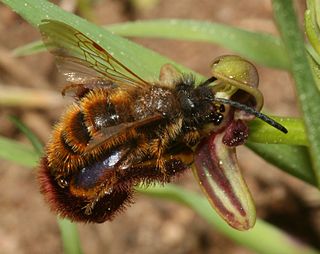
An allomone is a type of semiochemical produced and released by an individual of one species that affects the behaviour of a member of another species to the benefit of the originator but not the receiver. Production of allomones is a common form of defense against predators, particularly by plant species against insect herbivores. In addition to defense, allomones are also used by organisms to obtain their prey or to hinder any surrounding competitors.
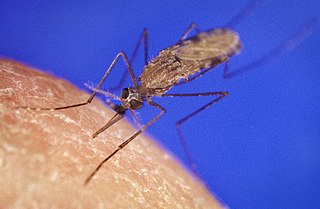
The Anopheles gambiae complex consists of at least seven morphologically indistinguishable species of mosquitoes in the genus Anopheles. The complex was recognised in the 1960s and includes the most important vectors of malaria in sub-Saharan Africa, particularly of the most dangerous malaria parasite, Plasmodium falciparum. It is one of the most efficient malaria vectors known. The An. gambiae mosquito additionally transmits Wuchereria bancrofti which causes lymphatic filariasis, a symptom of which is elephantiasis.

The diamondback moth, sometimes called the cabbage moth, is a moth species of the family Plutellidae and genus Plutella. The small, grayish-brown moth sometimes has a cream-colored band that forms a diamond along its back. The species may have originated in Europe, South Africa, or the Mediterranean region, but it has now spread worldwide.

Icerya is a genus of scale insects in the family Monophlebidae. It is named after physician-naturalist Dr. Edmond Icery of British Mauritius.
Sex pheromones are pheromones released by an organism to attract an individual of the same species, encourage them to mate with them, or perform some other function closely related with sexual reproduction. Sex pheromones specifically focus on indicating females for breeding, attracting the opposite sex, and conveying information on species, age, sex and genotype. Non-volatile pheromones, or cuticular contact pheromones, are more closely related to social insects as they are usually detected by direct contact with chemoreceptors on the antennae or feet of insects.

May Roberta Berenbaum is an American entomologist whose research focuses on the chemical interactions between herbivorous insects and their host plants, and the implications of these interactions on the organization of natural communities and the evolution of species. She is particularly interested in nectar, plant phytochemicals, honey and bees, and her research has important implications for beekeeping.

Spodoptera littoralis, also referred to as the African cotton leafworm or Egyptian cotton leafworm or Mediterranean brocade, is a species of moth in the family Noctuidae. S. littoralis is found widely in Africa, Mediterranean Europe and Middle Eastern countries. It is a highly polyphagous organism that is a pest of many cultivated plants and crops. As a result, this species was assigned the label of A2 quarantine pest by the EPPO and was cautioned as a highly invasive species in the United States. The devastating impacts caused by these pests have led to the development of both biological and chemical control methods. This moth is often confused with Spodoptera litura.
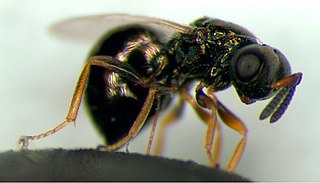
Nasonia vitripennis is one of four known species under the genus Nasonia - small parasitoid wasps that afflict the larvae of parasitic carrion flies such as blowflies and flesh flies, which themselves are parasitic toward nestling birds. It is the best known and most widely studied of the parasitoid wasps, and their study forms a vital part of the information used to describe the order Hymenoptera, along with information from bees and ants. This parasitoid behaviour makes the wasps an interest for the development of biopesticide and biological systems for controlling unwanted insects.
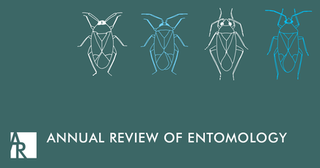
The Annual Review of Entomology is a peer-reviewed academic journal that publishes review articles about entomology, the study of insects. First published in 1956 from a collaboration between the Entomological Society of America and Annual Reviews, its longest-serving editors are Thomas E. Mittler (1967–1997) and May Berenbaum (1998–2018). As of 2023, Annual Review of Entomology is being published as open access, under the Subscribe to Open model. As of 2023, Journal Citation Reports gives the journal a 2022 impact factor of 23.8, ranking it first of 100 journals in the category "Entomology".
Helicoverpa assulta, the oriental tobacco budworm, is a moth of the family Noctuidae. H. assulta adults are migratory and are found all over the Old World Tropics including Asia, Africa, and Australia.
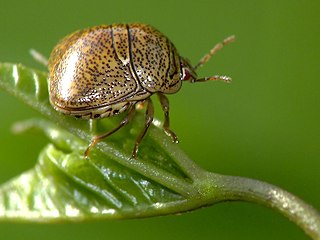
Megacopta cribraria, also called the bean plataspid, kudzu bug, globular stink bug and lablab bug, is a shield bug native to India and China, where it is an agricultural pest of lablab beans and other legumes. The bug, while harmless to houseplants and people, often enters houses. It is attracted to white surfaces such as the walls of houses or white vehicles, because of the high reflectance of the white surfaces as it relates to the bugs' simple eyes. As a defense mechanism, they emit a foul-smelling pheromone that also acts as a congregation pheromone. Aside from smelling foul, the liquid also creates a burning sensation and sometimes leaves a red welt on bare skin. It is similar to other Plataspidae in having a somewhat unusual symbiotic relationship with its gut bacteria. Before laying eggs, females deposit particles containing the symbiont, which are then eaten by newly hatched nymphs under natural conditions. Nymphs experimentally deprived of access to the symbiont exhibited slower growth, smaller body sizes and higher mortality.
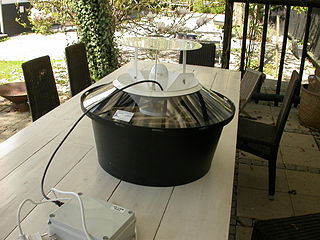
Moth traps are devices used for capturing moths for scientific research or domestic pest control.

Insect olfaction refers to the function of chemical receptors that enable insects to detect and identify volatile compounds for foraging, predator avoidance, finding mating partners and locating oviposition habitats. Thus, it is the most important sensation for insects. Most important insect behaviors must be timed perfectly which is dependent on what they smell and when they smell it. For example, olfaction is essential for locating host plants and hunting prey in many species of insects, such as the moth Deilephila elpenor and the wasp Polybia sericea, respectively.

Oecanthus nigricornis is a "common tree cricket" in the subfamily Oecanthinae. A common name for O. nigricornis is black-horned tree cricket. It is found in North America.
Curtis Paul Clausen was an American entomologist and professor at the University of California, Riverside, who specialized in biological control. He wrote an influential text on the biology of insect predators and parasites, Entomophagous Insects (1940).
Anopheles sundaicus is a zoophilic mosquito of southeast Asia.
References
- 1 2 3 4 5 6 7 Burkholder, Wendell E.; Ma, Michael (1985). "Pheromones for Monitoring and Control of Stored-Product Insects". Annual Review of Entomology . Annual Reviews. 30 (1): 257–272. doi:10.1146/annurev.en.30.010185.001353. ISSN 0066-4170. S2CID 85656973.
- 1 2 3 4 5 6 7 8 9 10 11 12 13 14 Wegler, Richard, ed. (7 March 2013). Herbizide[Herbicides]. Chemie der Pflanzenschutz- und Schädlingsbekämpfungsmittel [Chemistry of Plant Protection and Pesticidal Substances]. Vol. 5. Berlin, Heidelberg. pp. XXI+754. doi:10.1007/BF02040406. ISBN 978-3-642-66616-2. OCLC 913650212. S2CID 27560418.
{{cite book}}: CS1 maint: location missing publisher (link) ISBN 978-3642666179. - 1 2 Raina, Ashok K. (1993). "Neuroendocrine Control of Sex Pheromone Biosynthesis in Lepidoptera". Annual Review of Entomology . Annual Reviews. 38 (1): 329–349. doi:10.1146/annurev.en.38.010193.001553. ISSN 0066-4170. PMID 8424626.
- 1 2 3 4 El-Sayed, A. M.; Suckling, D. M.; Byers, J. A.; Jang, E. B.; Wearing, C. H. (2009-06-01). "Potential of "Lure and Kill" in Long-Term Pest Management and Eradication of Invasive Species". Journal of Economic Entomology . Entomological Society of America (OUP). 102 (3): 815–835. doi:10.1603/029.102.0301. ISSN 0022-0493. PMID 19610395. S2CID 16623066.
- 1 2 3 Phillips, Thomas W.; Throne, James E. (2010-01-01). "Biorational Approaches to Managing Stored-Product Insects". Annual Review of Entomology . Annual Reviews. 55 (1): 375–397. doi:10.1146/annurev.ento.54.110807.090451. hdl: 2097/12419 . ISSN 0066-4170. PMID 19737083.
- ↑ United States Environmental Protection Agency (2006-08-09). "Lepidopteran Pheromones; Exemption from the Requirement of a Tolerance". Federal Register. pp. 45395–45400. Retrieved 2022-04-20. 71 FR 45395. 40 CFR 180. EPA-HQ-OPP-2006-0529FRL-8083-8. Doc. No. E6-12971.